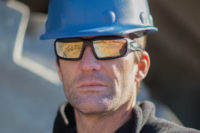
More than 33,000 occupational eye injuries required time off from work in 2007, according to Prevent Blindness America. According to the U.S. Bureau of Labor Statistics, eye injuries lead to more than 37,000 missed days of work per year and more than $300 million in related costs — not including costs from legal fees, judgments, productivity losses and a host of other indirect costs, bringing the total to more than $900 million.
The truth is that 90 percent of workplace eye injuries occur because workers are not wearing safety eyewear or are wearing the wrong safety eyewear. Prevention offers enormous upside potential. Increasing compliance for eye protection is one of the most effective means to increase worker safety and productivity.
Choose the right protection
Selecting eye protection for specific work environments requires an understanding of the nature and degree of the potential hazards and the circumstances of exposure. You must understand the unique safety requirements of your workplace environment, such as the need to protect against exposure to chemicals, dust, UV radiation or other hazards.
Once all hazards are identified, it is critical to determine which products best suit the needs of the employees who work in this environment each day. The ANSI Z87.1-2003 standard contains a selection chart to help companies choose the proper eye and face protection for particular job applications. The eyewear chosen must meet the ANSI Z87 standard in the United States or the CSA Z94.3 standard in Canada. It should provide the appropriate amount of coverage and should fit each individual worker properly and comfortably.
Comfort is the key
While protective eyewear must provide some level of style to increase worker acceptance, comfort is the key to keeping workers protected. If the eyewear is comfortable, workers are more likely to wear it and keep it on over longer periods of time, reducing the risk of injury.
Selection considerations include:
- Padded temples cushion the point of contact between the temple and the area behind the ear, making the eyewear more comfortable.
- Adjustable temple lengths allow the wearer to adjust the temples so they rest correctly upon their ears and provide a secure fit.
- Adjustable lens inclination allows the angle of the lens to be adjusted up or down. This helps to ensure that the lens is positioned correctly and helps improve coverage.
- An adjustable, padded nose piece ensures that the eyewear rests comfortably on the nose without pinching or slipping.
Varying work environments warrant different lens tints. The dyes used in tinted lenses absorb select wavelengths of radiant energy (light), and reduce the hazard or provide distinctive filtration for specific viewing tasks. For example, brown or amber tints are ideal for outdoor work environments because they protect against sunlight and glare. Orange lens tints are ideal for protecting against UV radiation and glare caused by the presence of blue light, such as in dental and related medical applications.
Used appropriately, the proper tint can increase worker productivity, reduce eye strain and fatigue and prevent blindness by protecting against the dangers of UV and infrared radiation.
Replace lenses for less
Purchasing replacement lenses rather than a new pair of safety eyewear is one way to reduce your annual safety eyewear expenditures. This is also an excellent option for workers who require more than one lens tint. In addition, workers may be able to wear higher quality eyewear for less money over time.
This example illustrates the savings for a worker who uses six pairs of eyewear per year. The costs shown are retail prices of similar style eyewear:
- Eyewear A costs ($9.50) + 5 Replacement Lenses @$3.25 ea. ($16.25) = Annual Cost ($25.75)
- Eyewear B costs ($6.50) + 5 Replacement Eyewear @$6.50 ea. ($32.50) = Annual Cost ($39.00)
- Annual savings per worker = $13.25.
Quality and lens coatings matter
Buying so-called “low cost” eyewear may not be a bargain in the long run if you find that you need to replace your workers’ eyewear frequently. Quality does matter, and spending a little bit more up front can make a big difference in the long run.
Lens coatings — especially anti-scratch coatings — provide added value by extending the life of the lens. One safety manager found, on average, his workers were replacing their eyewear twice a day because of lens scratching. The eyewear cost $2.00 per pair, or $4.00 a day per worker. After evaluating the options, the company decided to upgrade to eyewear with a high-performance, anti-scratch coating that cost $6.00 per pair — three times as much as they had been spending.
The result: workers averaged 12 days per pair of eyewear, compared to the half-day they were getting before. By switching to a more expensive pair of eyewear, the company saved $42.00 per worker every 12 days. On an annual basis, that added up to nearly $900 per worker. For this company, making a small change made a huge difference.
Bottom line
While budget reductions can be challenging, making smart eye protection choices helps you improve safety while saving money. If unsure about choosing appropriate eye and face protection, there are many resources available including OSHA-certified trainers and consultants, as well as distributor and manufacturer’s representatives who can perform an eyewear assessment to determine products that best fit the needs of your workplace.
Selecting eyewear that offers the best functionality, style and comfort will help increase user compliance and build a stronger culture of safety. This can translate into fewer incidents of eye injury and ultimately to increased productivity and profitability.

